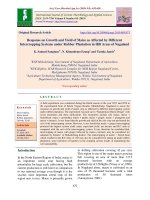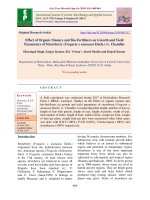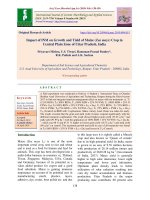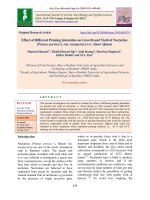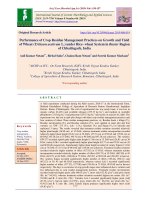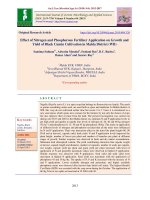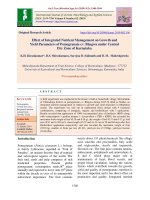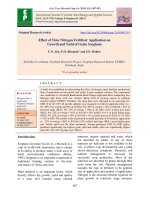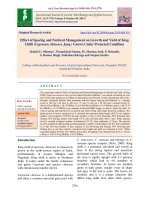Impact of INM on growth and yield of maize (Zea mays) crop in central plain zone of Uttar Pradesh, India
Bạn đang xem bản rút gọn của tài liệu. Xem và tải ngay bản đầy đủ của tài liệu tại đây (289.68 KB, 13 trang )
Int.J.Curr.Microbiol.App.Sci (2019) 8(4): 138-150
International Journal of Current Microbiology and Applied Sciences
ISSN: 2319-7706 Volume 8 Number 04 (2019)
Journal homepage:
Original Research Article
/>
Impact of INM on Growth and Yield of Maize (Zea mays) Crop in
Central Plain Zone of Uttar Pradesh, India
Priyavart Mishra, U.S. Tiwari, Hanuman Prasad Pandey*,
R.K. Pathak and A.K. Sachan
Department of Soil Science and Agricultural Chemistry
C.S. Azad University of Agriculture and Technology, Kanpur, Uttar Pradesh – 208002, India
*Corresponding author
ABSTRACT
Keywords
Zea mays, Growth,
Yield, Azad Uttam,
FYM, Grain, Stalk
Article Info
Accepted:
04 March 2019
Available Online:
10 April 2019
A field experiment was conducted at field no. 6 Student‟s Instructural Farm at Chandra
Shekhar Azad University of Agriculture and Technology, Kanpur during the Kharif season
2017 to find out integrated nutrient management effect on maize with ten treatments i.e. T 1
(125% RDN), T2 (100% RDN), T3 (100% RDN + 25% N FYM), T 4 (100% RDN + 25% N
FYM + S30), T5 (100% RDN + 25% N FYM + S30 + Zn5), T6 (75% RDN), T7 (75% RDN +
25% N FYM), T8 (75% RDN + 25% N FYM + S30), T9 (75% RDN + FYM + S30 + Zn5),
T10 (Control) in RBD with 3 replications. Maize variety Azad Uttam was taken for study.
The results revealed that the grain and stalk yield of maize respond significantly with the
different treatment combination. The result showed highest grain yield (35.25 q ha-1) and
stalk yield (97.99 q ha-1) with the application of 100% RDN + 25% N FYM + S30 + Zn5 ha1
, which was 88 % and 63.31 % higher to lowest grain yield (18.75 q ha-1) and stalk yield
(60 q ha-1) at control. The maximum growth and yield in case of all treatments was found
in T5 (100% RDN + 25% N FYM + S30 + Zn5) and lowest in T10 (Control).
to this large uses it is rightly called a Miracle
crop and also known as „Queen of cereals‟
due to its high potential yield. In India, maize
is grown in an area of 9.76 million hectares
with production of 26.14 million tonnes and
productivity of 2629.28 kg ha-1 (Government
of India, 2017). Maize yield is generally
higher in high solar intensities, lower night
temperature and lower pest infestation.
Optimum plant density leads to better
utilization of solar radiation resulting into
corn dry matter accumulation and biomass
production. Uttar Pradesh is the major
producing state contributes 60 percent area
Introduction
Maize (Zea mays L.) is one of the most
important cereal crop, next to rice and wheat
and is used as a food for human and feed for
animals. This crop has been developed into a
multi dollar business in countries viz. Thiland,
Tiwan, Singapore, Malaysia, USA, Canada
and Germany, because of its potential as a
value added product for export and a good
food substitute. Maize is gaining immense
importance on account of its potential uses in
manufacturing starch, plastics, rayon,
adhesive, dye, resins, boot polish etc. and due
138
Int.J.Curr.Microbiol.App.Sci (2019) 8(4): 138-150
corn with application of 80 kg N ha-1 over
control.
and 70 percent of maize production in India.
Abbasi et al., (2010) reported that application
of the highest rate of N (150 kg ha-1) recorded
the highest grain yields (3763 kg ha-1) of
maize. The proportional increase in maize
yield for Nitrogen (90 kg N ha-1) + poultry
manure (30 kg N ha-1) and Nitrogen (60 kg N
ha-1) + poultry manure (60 kg N ha-1) was 85
and 83%, respectively.
Kumar et al., (2017) observed that application
of S and Zn has resulted in significant
improvement for crude protein, Ca, ash in
baby corn. Application of 125% RDF (187.593.7-75 kg ha-1) and 50 kg S ha-1 along with
10 kg Zn ha-1 has great impact on corn
production in maximum corn yield, fodder
yield, nutrient content and monetary returns to
the growers.
Baral and Adhikari (2013) reported that 15%
yield increased when 10 t ha–1 FYM applied
with azotobacter.
Kumar et al., (2017) revealed that treatment
T3 (150% RDF) recorded significantly higher
growth parameters and yield attributes viz.
plant height (201.90 cm), number of grains
cob-1 (393.20), test weight (223.25 g) and
grain yield (52.05 q ha ha-1) which was
closely followed by treatment T5 (RDF+5
tons FYM ha–1 and recorded plant height
(200.30 cm), number of grains cob-1 (391.95),
test weight (223.15 g) and grain yield (51.70
q ha ha-1) and was found to be at par to
treatment T3.
Bindhani et al., (2007) reported that the
application of 120 kg N ha-1 resulted in tallest
plant with maximum dry matter yield and leaf
area index which is significantly higher t5han
80 kg N ha-1. They also reported a significant
increase in makeable baby corn plant-1 fresh
weight, length and girth with the application
of 120kg N ha-1.
Bindhani et al., (2008) reported that
application of 120 kg N ha-1 increase
significantly higher plant height, dry matter
production and leaf area index over other
treatment including control.
Mehta et al., (2011) noted the maximum dry
matter accumulation, leaf area index and crop
growth rate in maize with application of 275
kg ha-1 N which was statistically at par with
250 kg nitrogen ha-1 but significantly higher
over control.
Dilshad et al., (2010) observed that
application of RDF (120 kg N+ 90 kg P2O5 +
60 kg K2O ha-1) or 50 per cent of RDF +
FYM 10 t ha-1 + bio powder resulted in
significantly greater plant height of maize
over other treatments including control.
Mehta et al., (2005) reported significant
increase in cobs plant-1 of maize with
application of 100 % RDF along with FYM at
10 t ha-1 over control.
El-Kholy et al., (2005) noted that application
of Azospirillum brasilense and soil yeast
Rhodotorula glutinis in the presence of 100%
NPK gave significant increases in plant
height, leaf area index, grain and straw yield
of maize over 100 % NPK alone.
Sahoo and Mahapatra (2005) reported
significant increase in cobs plant-1 and weight
of cob of maize were noted with application
of increasing levels of nitrogen fertilizers.
Kar et al., (2006) reported significantly higher
number of cobs plant-1, length of cob, girth of
cob, grains cob-1 and weight of cob of sweet
Satish et al., (2011) reported higher grain
(4402 kg ha-1) and straw (5888 kg ha-1) yield
in summer maize in treatments with both
139
Int.J.Curr.Microbiol.App.Sci (2019) 8(4): 138-150
organic and inorganic fertilizers in kharif
followed by 100 percent NPK in summer
season, thus showing the beneficial effect of
organic sources of nutrients on the succeeding
crop and also improving the soil fertility
levels.
Thirupathi et al., (2016) reported that
applicatio0n of N and S @ 225 and 60 kg ha-1
recorded highest grain yield, stover yield,
crude protein content and B:C ratio than other
N and S contribution but it was on par with N
and S @ 225 and 80 kg ha-1.
Sepat and Kumar (2007) observed significant
increases in plant height and dry matter
accumulation of maize crop with application
of increasing levels of nitrogen up to 120 kg
ha-1.
Verma et al., (2006) found significant
increase in plant height, dry matter
production, leaf area index, crop growth rate
and net assimilation rate at 30, 60 and 90
DAS of maize crop with application of NPK
at 90, 30 and 15 kg ha-1, respectively over
control.
Shabnam et al., (2011) state that application
of FYM @ 5 t ha-1and lime @ 0.3 t ha-1
recorded maximum dry matter accumulation,
leaf area index and crop growth rate and
produced higher grain (4.162 t ha-1) and
stover (9.823 t ha-1) yields of maize under red
and lateritic soils of Ranchi.
Yadhav and Christopher Lourduraj (2006)
reported that the application of organic
manures, FYM, poultry manure, green leaf
manure and panchagavya spray resulted in
significant increase yield attributes of sweet
corn such as cob length, cob diameter and
number of grains per cob.
Shrivas et al., (2007) reported that application
of 33.33% (RN) through non- edible oil
cakes, 33.33 % (RN) through cow dung
manure and 33.33 % (RN) through enriched
compost recorded higher plant growth of
maize over rest of treatments.
Materials and Methods
The experiment was conducted on Maize
during kharif season of 2017 under natural
condition at field no. 6 Student‟s Instructural
Farm at Chandra Shekhar Azad University of
Agriculture and Technology, Kanpur. The soil
of the experimental field was alluvial in
origin. Soil sample (0-15cm) depths were
initially drawn from randomly selected parts
of the field before sowing. The quantity of
soil sample was reduced to about 500 gm
through quartering technique. The soil sample
was then subjected to mechanical and
chemical analysis in order to determine the
textural class and fertility status the soils were
sampled to a depth of 0-30 cm of the soil, airdried and sieved (2 mm) for soil analyses.
Some physical and chemical properties of
soils are given in Table 1.
Singh and Yadav (2007) found that
application of 100 % RDF (90 kg N + 17.5 kg
P ha-1) significantly improved plant height,
dry matter production and leaf area index of
maize over 75 per cent of RDF.
Singh et al., (2007) reported that application
of 40 kg N+ 30 kg P2O5 + 10 t FYM ha-1+
Azotobacter +VAM significantly enhanced
plant height and dry matter production of
maize over other treatments.
Sujatha et al., (2008) reported that application
of sunhemp green manure + poultry manure +
100 % RDN gave significantly higher total
dry matter accumulation plant-1, leaf area
index and cob yield plant-1 in maize over rest
of treatment combinations.
Maize variety Azad Uttam was taken for
study. In the present experiment 10 treatments
140
Int.J.Curr.Microbiol.App.Sci (2019) 8(4): 138-150
T1 (125% RDN), T2 (100% RDN), T3 (100%
RDN + 25% N FYM), T4 (100% RDN + 25%
N FYM + S30), T5 (100% RDN + 25% N FYM
+ S30 + Zn5), T6 (75% RDN), T7 (75% RDN +
25% N FYM), T8 (75% RDN + 25% N FYM
+ S30), T9 (75% RDN + FYM + S30 + Zn5), T10
(Control)were laid out in Randomized Block
Design(RBD) with three replications having
plot size 5 x 4 meter square. Doses of
fertilizers are applied @ 120 Kg N, 60 Kg
P2O5, 40 Kg K2O/ha 30 Kg S/ha, 5 Kg Zn/ha
and Organic manure 60 tonne/ha through
Urea, D.A.P and Murate of Potash, Elemental
sulphur, Zinc oxide and Farm Yard Manure.
Sowing is done @ 20 kg seed ha-1 maize
variety Azad Uttam was used and sown on 22
June 2017. Row to row and plant to plant
distance remain 60 and 20 respectively. Seed
were sown about 5-6 cm depth
depth. Intercultural operations: Weeding and
hoeing were done with khurpi and hand hoe
after germination. Irrigation: Tube-well was
the source of irrigation. Irrigation was
provided in the crop as and when required.
Harvesting: The crop was harvested at proper
stage of maturity as determined by visual
observations. Half meter length on either end
of each plot and two border rose from each
side as border were first removed from the
field to avoid error. The crop in net plot was
harvested for calculation on yield data.
Produce was tied in bundles and weighted for
biomass yield. Threshing of produce of each
net crop was done by manually.
Field preparation
The clean and dried grains from each plot
weighed with the help of electronic balance in
kg/ha and converted into q/ha. Stalk Yield:Stalk yield can be obtained by subtracting
grain yield from the biological yield.
Yield of crop
Grain yield
The experimental field was ploughed once
with soil turning plough fallowed by two
cross harrowing. After each operation,
planking was done to level the field and to
obtain the fine tilth. Finally layout was done
and plots were demarked with small sticks
and rope with the help of manual labour in
each block. Application of fertilizers: The
crop was fertilized as per treatment. The
recommended dose of nutrient i.e. N, P, and
K was applied @ 120: 60: 40 kg ha-1
respectively. Time and method of fertilizer:
Half does N2 and total phosphorus, potash,
zinc and sulphur were applied as basal
dressing. Remaining dose of nitrogen was
applied through top dressing after knee-high
stage. Well decompose FYM applied @ 60 t
ha-1 15 day after sowing. Seed Treatment: To
ensure the seeds free from seed borne
diseases, seeds were treated with thiram 75%
WDP (1.5g/kg of seed). Seed and sowing: 20
kg seed ha-1 maize variety Azad Uttam was
used and sown on 22 June 2017. Row to row
and plant to plant distance remain 60 and 20
respectively. Seed were sown about 5-6 cm
Observations recorded
The observations were recorded as per the
procedure described below. For this purpose 5
plants were selected randomly in each net plot
and were tagged with a level for recording
various observations on growth and yield
parameters. Biometric observation: Biometric
observation such as plant population, average
plant height at maturity, number of cobs,
length of cobs, test weight of 1000 grain, cob
girth, number of grain, number of row were
recorded treatment wise grain and stalk yields
were recorded per plot and converted into
quintal ha-1.
Soil analysis
Mechanical separates:- Soil separates
analyzed by International pipette method as
described by the Piper (1966). pH:- pH of the
141
Int.J.Curr.Microbiol.App.Sci (2019) 8(4): 138-150
soil determined by using soil water
suspension (1:2.5) with the help of digital pH
meter. EC:- EC also determined using soil
water suspension (1:2.5) with help of
conductivity meter (Jackson, 1967). Organic
carbon:- Organic Carbon was determined by
Walkley and Black‟s rapid titration method as
described by Jackson (1967). Available
Nitrogen:- It was determined by Alkaline
Potassium Permagnate Method described by
Subbiah and Asija (1956). Available
Phosphorus:- It is determined by Olsen‟s
method using 0.5 M NaHCO3 (Olsen et al.,
1954). Available Potassium:- Potassium is
determined by using Neutral Normal
Ammonium Acetate (pH 7.0) by Flame
Photometer. Available Sulphur:- Available
Sulphur was determined by turbidimetric
method (Chesnin and Yien,1950) after
extraction with 0.15%CaCl2 solution.
Available Zinc:- Available Zn is determined
by Atomic Absorption Spectrophotometer
with the help of DTPA extractant (Lindsey
and Norvell, 1978).
depicted in table 4.1 and figure 1 showed nonsignificant variation in plant population
within all the treatments. Maximum number
of plant plot-1 ha-1 (246) was recorded with
100% RDN + 25% N FYM + 30 kg + 5kg Zn
ha-1 followed by (244) with 75% RDN +25 %
N FYM + 30 kg S + 5 kg Zn ha-1 and
minimum (232) at control (T10). Integration of
FYM, sulphur and zinc showed nonsignificant variation in plant population when
applied with 75 % RDN and 100 % RDN.
Plant height
Data pertaining to plant height given in table
4.1 and figure 1 showed linear variation in all
the treatments. Maximum plant height 195 cm
was recorded with T5 (100% RDN + 25% N
FYM + 30 kg S + 5 kg Zn ha-1) followed by
244 cm with T9 (75% RDN + 25% N FYM +
30 kg S + 5 kg Zn ha-1) and minimum 179 cm
at control (T10). It is also obvious from the
data that plant height increased in all the
treatments in comparison to control but the
increase in plant height was recorded nonsignificant. Integration of sulpher, zinc and
FYM with 100% RDN and 75% RDN also
influenced plant height but the increase was
plant height recorded non-significant.
Statistical analysis
The data on various characters studied during
the course of investigation were statistically
analyzed for randomized block design.
Wherever treatment
differences
were
significant (“F” test), critical differences were
worked out at five per cent probability level.
The data obtained during the study were
subjected to statistical analysis using the
methods advocated by Chandel (1990).
Yield attributes
Number of cob plant -1
It is visualized from the data given in table
4.2 and figure 2 showed that number of cob
plant-1 influenced significantly in all the
treatment over to control. Maximum number
of cob (1.6 plant-1) was recorded with T5 (100
% RDN + 25% N FYM + 30 kg S + 5 kg Zn
ha -1) followed by (1.48 cob plant-1) T9 (75 %
RDN + 25 % N FYM + 30 kg S + 5 kg Zn
ha-1) and minimum (1.02 cob plant-1) at
control (T10). Integration of S, Zn and FYM
showed slight increase in number of cob
plant-1 when applied with 100% RDN and
75% RDN treatments. Variation in number of
Results and Discussion
Impact of INM on growth and yield
attributes of maize
Growth attributes
Plant population plot-1
Data in regard with plant population plot-1
was recorded at the time of crop harvest are
142
Int.J.Curr.Microbiol.App.Sci (2019) 8(4): 138-150
cobs plant-1 within 75% RDN and 100 %
RDN and 125% RDN was found nonsignificant.
given in table 4.3 and figure 3 showed no. of
rows cob-1 increase significantly in all the
treatment over to control. Integration of S, Zn,
and FYM showed slight increase in number of
rows cob-1 but the increase was found nonsignificant. Variation in number of rows cob-1
within 75 % RDN, 100 % RDN and 125 %
RDN was also found non-significant.
Girth of cob
Girth of cob as effected by different treatment
are given in table 4.2 And figure 2 showed
linear and non-significant variation within all
the treatments. Maximum cob girth 11.7 cm
was recorded with T5 (100 % RDN + 25% N
FYM + 30 kg S + 5 kg Zn ha-1) followed by
11.56 with T9 (75 % RDN + 25 % N FYM +
30 kg S + 5 kg Zn ha-1) and minimum 10.20
at control (T10). It was also observed that cob
girth cm-1 increased significantly in all the
treatment in comparison to control.
Integration of S, FYM and Zn showed nonsignificant increase in cob girth when applied
with 100% RDN and 75% RDN treatment.
Number of grains row cob-1
Data in regard to Number of grains row cob-1
given in table 4.4 and figure 4 showed
significant increase in all the treatment over
control. Maximum number of grain (19.6
cob-1) was recorded with T5 (100 % RDN +
25% N FYM + 30 kg S + 5 kg Zn ha-1)
followed by (19.0 cob-1) T9 (75% RDN + 25%
N FYM + 30 kg S + 5 kg Zn ha-1) and
minimum (16.0 cob-1) at control (T10).
Integration of S, Zn and FYM showed
significant increased in number of grains row
cob-1 when applied with 100 % RDN and
75% RDN treatments. Variation in number of
grain row cob-1 within 75 % RDN, 100%
RDN and 125 % RDN was also found
significant.
Cob length cm
Data in respect cob length was given in table
4.3 and illustrated in figure 3 showed
significant variation in all the treatment.
Maximum cob length (14.40 cm) was
recorded with T5 (100 % RDN + 25% N FYM
+ 30 kg S + 5 kg Zn ha-1) followed by (14.20
cm) T9 (75% RDN + 25% N FYM + 30 kg S
+ 5 kg Zn ha-1) and minimum (12.5 cm) at
control (T10). It was also observed that cob
length increased significantly in all the
treatment in comparison to control (T10).
Integration of S, FYM and Zn influenced cob
length significantly when applied with 100%
RDN and 75% RDN treatments. Variation in
cob length within 75% RDN, 100 RDN% and
125% RDN was also found significant.
Test weight (1000 grain)
Test weight as expressed by weight 1000
grains in gram is given in table 4.4 and figure
4. The results revealed that test weight was
non-significantly influenced by the different
treatments. Maximum increase in test weight
was recorded (220.50 gm) with T5 (100%
RDN + 25% N FYM + 30 kg S + 5 kg Zn ha1
) followed by (218.40 gm) T9 (75% RDN +
25 % N FYM + 30 kg S + 5 kg Zn ha-1) and
minimum (214.60 gm) at control (T10). It was
also observed that all the treatments showed
significant increase in test weight over
control. Integration of S, FYM and Zn
showed positive effects when applied with
100% RDN and 75% RDN treatments but the
increase was found non- significant. Variation
Number of rows cob-1
Number of rows cob-1 varied from 7.66 to
11.33 and variation in number of rows cob -1
within all the treatments was found nonsignificant. It is also obvious from the data
143
Int.J.Curr.Microbiol.App.Sci (2019) 8(4): 138-150
in test weight within 75% RDN, 100% RDN
and 125% RDN was recorded significant.
significant. It was also observed that
treatment receiving 125% (T1) inorganic
fertilizer produced higher grain yield in
comparison to 100% RDN and 25% N FYM
(T3) but the increase was found nonsignificant. Substitution of 25 % N FYM with
75 % RDN produced lower grain yield than
100% RDN but yield difference within these
treatment was found comparable and at par. It
is interesting to show that integration of
FYM, sulphur and Zn showed higher increase
in grain yield when applied with 75% RDN in
comparison to 100% RDN treatment.
Yield
Biological yield
It is apparent from the data given in table 4.5
and figure 5 that biological yield of maize
increase significantly in all the treatments in
comparison to control (T10) maximum
biological yield (133.24 q ha-1) was recorded
with T5 (100 % RDN + 25% N FYM + 30 kg
S + 5 kg Zn ha-1) followed by (123.88 q ha-1)
with T9 (75 % RDN + 25 % N FYM + 30 kg
S + 5 kg Zn ha-1) and minimum (78.75 q ha-1)
at control (T10). Variation in biological yield
within 75% RDN, 100% RDN and 125%
RDN was found significant. Integration of S,
FYM and Zn also showed significance
increase in biological yield when applied with
75% RDN and 100% RDN treatments.
Stalk yield
Data in regard to stalk yield given in table 4.5
and figure 5 showed significant increase in all
the treatments in comparison to control.
Maximum stalk yield (97.99 q ha-1) was
recorded with T5 (100% RDN + 25% N FYM
+ 30 kg S + 5 kg Zn ha-1) which was (63.31%)
higher than control. Integration of FYM,
sulphur and zinc produced 85.69 q ha-1, 91.65
q ha-1 and 97.99 q ha-1 over yield when
applied with 100% RDN and 6.02 %, 7.30%
and 7.35% more when applied with 75 %
RDN treatment respectively. Variation in
stalk yield within 75% RDN, 100% RDN and
125% RDN was found significant. It was also
observed that substitution of 25% N FYM
produced stalk yield at par to 100% RDN.
Super imposition of 25% N through FYM
with 100% RDN also produced stalk yield at
par to 125% RDN.
Grain yield
It is apparent from the data depicted in table
4.5 and illustrated in figure 5 showed that all
the treatment significantly influenced the
grain yield over control. Higher grain yield
(35.25 q ha-1) was recorded with T5 (100 %
RDN + 25% N FYM + 30 kg S + 5 kg Zn ha1
) which was (88%) higher to the lowest grain
yield (18.75 q ha-1) of control (T10) and (31.04
%) higher to 100 % RDN (T2). Integration of
30 kg sulphur ha-1 with 100 % RDN + 25% N
FYM produced (11.87%) more grain yield in
comparison to 100 % RDN + 25% N FYM
(T3). Likewise integration of 5 kg zinc with
100% + 25% N FYM + 30 kg sulphur ha-1
influenced (8.46%) higher grain yield in
comparison to 100% RDN + 25 % N FYM +
30 kg sulphur ha-1. Super imposition of 25%
N through FYM with 100% RDN (T3)
produced (7.99 %) higher grain yield over
100 % RDN (T2). Variation in grain yield
within 75% RDN and 100% RDN was found
Impact of INM on growth attributes, yield
attributes and yield
The study encompasses observations on
growth parameters and yield attributing
characters were taken. The characters
included in study were plant population plot-1,
plant height (cm.) at harvest stage of the crop,
no. of cob plant-1, girth of cob (cm.), no. of
rows cob-1, no. of grain cob-1 and test weight
144
Int.J.Curr.Microbiol.App.Sci (2019) 8(4): 138-150
(1000 grain) gm. At the harvest the data were
recorded on biological yield, grain yield and
stalk yield.
results have been reported by Bindhani et al.,
(2007), El-Kholy et al., (2005), Mehta et al.,
(2011), Kumar (2008) and Singh and Yadav
(2007).
Growth attributes
Yield attributes
Plant population
Yield attributes parameter that has been given
in table 4.2 to table 4.4 and figure 2 to 4
showed that significant increase in yield
attributing parameter in all the treatments
over control. Maximum yield attributing
parameter was recorded with T5 (100 % RDN
+ 25 % N FYM + 30 kg S + 5 kg Zn ha-1)
followed by T9 (75% RDN + 25% N FYM +
30 kg S + 5 kg Zn ha-1) and minimum at
control (T10). Addition of S, Zn and FYM
with 100% RDN and 75% RDN also
accelerate yield attributing parameters but the
increase in yield attributing parameters in
general was found non-significant. Increase in
yield attributing parameters within 75% RDN,
100% RDN and 125% RDN were noted in
general significant. Increase in yield
attributing parameters might be attributed to
increase cell expansion and various metabolic
processes in the presence of adequate
available nutrient. Results in this study are
agreement with those of following workers
Sahoo and Mahapatra (2005), Kar et al.,
(2006), Mehta et al., (2011) and Kumar
(2008).
Plant population varied from 234 to 246 in all
the treatment and variation in plant population
within all the treatment was noted nonsignificant.
This indicated that nutrient treatment was
affected in plant population. Plant population
could be affected due to seeding, germination
percentage etc. These findings are related to
the findings of Verma et al., (2006), Jena et
al., (2013) and Shrivas et al., (2007)
Plant height
Plant height was measured at harvest stage.
Perusal of the data given in table 4.1 and
figure 1 showed that plant height increase
significantly in all the treatment over control.
Plant height varied from 174 to 195 cm plant-1
within all the treatments. Addition of FYM, S,
Zn influenced plant height when applied with
100% RDN and 75 % RDN. Significant
variation in plant height was noted within
75% RDN, 100% RDN and 125% RDN.
Maximum plant height 195 cm. was recorded
with T5 (100% RDN + 25% N FYM + 30 kg
S + 5 kg Zn ha-1) which were 35.71% higher
than control. This indicates that the nutrient
application
resulted
in
augmented
photosynthetic activity due to combined and
balance effect of nutrients in maize.
Impact of INM on grain and stalk yield
A perusal of the data presented in table 4.5
and illustrated in figure clearly revealed that
all the treatment significantly influenced the
grain and stalk yield over control. The highest
grain yield 35.25 q ha-1 and stalk yield 97.99
q ha-1were recorded with T5 (100% RDN + 25
% N FYM + 30 kg S + 5 kg Zn ha-1) which
was 88% and 63.31% higher than yield of
control (T10). Integration of 30 kg S ha-1
produced 11.87% and 13.01% higher grain
and 6.95% and 5.67% stalk yield with 100%
Significant increase in cell division and
growth was also manifested in terms of plant
height. Increase in plant height due to
integration of S and Zn and organic manure
with 100% inorganic fertilizers. Similar
145
Int.J.Curr.Microbiol.App.Sci (2019) 8(4): 138-150
and 75% RDN. Like-wise S integration of 5
kg Zn also produces 8.46% and 8.84% higher
grain and 6.91% and 6.87% stalk yield with
100% and 75% RDN. Super imposition of
FYM with 100% RDN and substitution of
25% N through FYM with 75% RDN also
influenced 7.99% 8.82% higher grain and
5.49% and 7.07% higher stalk yield. It is also
obvious from the data that 100% RDN
produced 10.47% more grain and 7.61%
higher stalk yield over 75% RDN.
Application 125% RDN also produced 8.55%
higher grain and 5.31% higher stalk over
100% RDN. It is interesting to report here that
integration of 25% N through FYM with
100% RDN produced grain and stalk yield on
par to 125% RDN.
Table.1 Some properties of the <2mm fraction of the top 30 cm of soil used for the site
S.No.
A.
1.
2.
3.
4.
B.
5.
6.
7.
8.
9.
10.
11.
12.
13.
14.
15.
Particulars
Mechanical separates
Sand (%)
Silt (%)
Clay (%)
Textural Class
Physico-chemical properties
pH (1:2.5)
EC (1:2.5) (dS/m at 250C)
Organic Carbon (%)
Available Nitrogen (kg/ha)
Available Phosphorus (kg/ha)
Available Potassium (kg/ha)
Available Sulphur (kg/ha)
Available Zinc (ppm)
Particle Density (Mg/m3)
Bulk Density (Mg/m3)
Pore Space (%)
Values
59.6
17.4
23.00
Sandy loam
8.2
0.20
0.36
190.00
13.50
182
15.80
0.56
2.54
1.30
46.0
Table.2 Impact of integrated nutrient management on growth attributes of maize
Plant Population plot-1
240
238
239
243
246
235
237
241
244
232
5.59
16.93
S.No. Treatment
T1 = 125% RDN
1.
T2 = 100% RDN
2.
T3 = 100% RDN + 25% N FYM
3.
T4 = 100% RDN + 25% N FYM + S30
4.
T5 = 100% RDN + 25% N FYM + S30 + Zn5
5.
T6 = 75% RDN
6.
T7 = 75% RDN + 25% N FYM
7.
T8 = 75% RDN + 25% N FYM + S30
8.
T9 = 75% RDN + FYM + S30 + Zn5
9.
T10 = Control
10.
S. E.
C. D. (at 5 %)
146
Plant Height (cm)
191
189
190
193
195
186
188
192
194
170
0.325
0.973
Int.J.Curr.Microbiol.App.Sci (2019) 8(4): 138-150
Table.3 Impact of integrated nutrient management on yield attributes of maize
S.NO.
1.
2.
3.
4.
5.
6.
7.
8.
9.
10.
Treatments
T1
T2
T3
T4
T5
T6
T7
T8
T9
T10
S.E.
No of cob plant-1
1.35
1.15
1.25
1.45
1.60
1.08
1.12
1.38
1.48
1.02
0.019
Girth of cob (cm.)
11.10
10.76
10.85
11.50
11.70
10.40
10.58
11.30
11.56
10.20
0.027
0.058
0.082
C.D. (at 5 %)
Table.4 Impact of integrated nutrient management on yield attributes of maize
S.No.
1.
2.
3.
4.
5.
6.
7.
8.
9.
10.
Treatments
T1
T2
T3
T4
T5
T6
T7
T8
T9
T10
S. E.
Cob length (cm)
13.75
13.20
13.50
14.05
14.40
12.80
13.05
13.85
14.20
12.5
0.033
No of rows cob-1
10
9.67
9.67
10.67
11.33
8
9.67
10.00
10.67
7.66
0.325
0.100
0.974
C. D. (at 5 %)
Table.5 Effect of integrated nutrient management on yield attributes of maize
S.No.
1.
2.
3.
4.
5.
6.
7.
8.
9.
10.
Treatments
T1
T2
T3
T4
T5
T6
T7
T8
T9
T10
S. E.
C. D. (at 5 %)
No of grains row cob-1
17.8
17.20
17.60
18.08
19.60
16.80
17.00
18.20
19.00
16.00
0.217
Test weight (1000 grain) (gm)
217.20
216.80
217.05
218.10
220.50
215.50
216.30
217.50
218.40
214.60
0.811
0.649
2.429
147
Int.J.Curr.Microbiol.App.Sci (2019) 8(4): 138-150
Table.6 Impact of integrated nutrient management on yield of maize
S.No.
1.
2.
3.
4.
5.
6.
7.
8.
9.
10.
Treatments
T1
T2
T3
T4
T5
T6
T7
T8
T9
T10
S. E.
C. D. (at 5 %)
Grain yield (q ha-1)
29.20
26.90
29.05
32.50
35.25
24.35
26.50
29.95
32.60
18.75
0.876
2.622
Stalk yield (q ha-1)
85.55
81.23
85.69
91.65
97.99
75.48
80.82
85.41
91.28
60.00
0.559
1.674
It was also observed that substitution of 25%
N through FYM with 75% RDN produces
grain yield at par to 100% RDN. Increase in
grain and stalk yield might be due to
increasing in growth and yield attributes of
maize and due to integration of S, Zn and
organic manure with inorganic fertilizer.
Organics besides release their own nutrient
might have increase in the nutrient use
efficiency of applied inorganic fertilizer in
maize crop. The result of the present study is
in agreement with those of several
investigators Sujatha et al., (2008), Karasu
(2012) and Kumar et al., (2017).
Biological yield
114.75
108.13
114.74
124.15
133.24
99.83
107.32
115.36
123.88
78.75
1.435
4.296
(q ha-1)
125% RDN was noted significant. Increase in
biological yield with graded dosed of RDN
and integration of S, Zn and FYM may be due
to that all the nutrient element is associated
with the metabolism of nutrient in plant life
cycle. These results are in the line of the
findings of Abbasi et al., (2010) and
Choudhary et al., (2007).
References
Abbasi, M.K., Khaliq, A., Shafiq, M., Kazmi,
M. and Ali, I. (2010). Comparative
Effectiveness of Urea N, Poultry
Manure and their Combination in
Changing Soil Properties and Maize
Productivity under Rainfed Conditions
in Northeast Pakistan. Experimental
Agriculture, 46(2): 211-230.
Begum, M., Narayanaswamy, G., Rai, K. K.
and Biswas D. R. (2007). Influence of
integrated nutrient management on
nitrogen and phosphorus in soil under
wheat- mungbean- maize cropping
system. Journal of the Indian Society of
Soil Science. 55 (2): 175-183.
Bindhani, A., Barik, K.C., Garnayak, L.M.
and
Mahapatra,
P.K.
(2008).
Productivity and nitrogen use efficiency
Biological yield
Impact of INM on biological yield of maize
presented in table 4.5 and fig. 4.5 showed
significant increase in biological yield in all
the treatments over control. Maximum
biological yield was 133.24 q ha-1 was noted
with T5 (100% RDN + 25% N FYM + 30 kg
S + 5 kg Zn ha-1) which was found 69.19%
higher over the yield 78.75 q ha-1 of control.
Addition of S, Zn and FYM also influenced
biological yield when applied with 100%
RDN and 75% RDN. Variation in biological
yield within 75% RDN, 100% RDN and
148
Int.J.Curr.Microbiol.App.Sci (2019) 8(4): 138-150
of baby corn (Zea mays L.) at different
levels and timing of nitrogen
application under rainfed conditions.
Indian Journal of Agricultural Sciences
78:629-631.
Bindhani, A., Barik, K.C., Garnayak, L.M.
and Mahapatra, P.K. (2007). Nitrogen
management in baby corn (Zea mays
L.). Indian Journal of Agronomy 52:
135-138.
Choudhary, M.L., Singh, A. and Parihar,
C.M. (2007). Forage production
potential of maize (Zea mays L.) under
different nitrogen levels and crop
geometry. Agronomy Digest 7: 17-18.
Dilshad, M.D., Lone, M.I., Jilani, G., Azim
Malik, M., Yousaf, M. Khalid, R. and
Shamin, F. (2010). Integrated nutrient
management (IPNM) on maize under
rainfed condition. Pakistan Journal of
Nutrition 9: 896-901.
El-Kholy, M.A., El-Ashry, S. and Gomaa,
A.M. (2005). Biofertilization of maize
crop and its impact on yield and grains
nutrient content under low rates of
mineral fertilizers. Journal of Applied
Sciences Research 1: 117-121.
Kar, P.P., Barik, K.C., Mahapatra, P.K.,
Garnayak, L.M., Rath, B.S., Bastia,
D.K. and Khanda, C.M. (2006). Effect
of planting geometry and nitrogen on
yield, economics and nitrogen uptake of
sweet corn (Zea mays L.). Indian
Journal of Agronomy 51: 43-45.
Karforma, J., Ghosh, M., Ghosh, D. C. and
Mandal, S. (2012). Effect of integrated
nutrient management on growth,
productivity, quality and economics
o++f fodder maize in rainfed upland of
Terai region of West Bengal.
International Journal of Agric. Env.
Biotech, 5(4): 419-427.
Kumar A., Tripathi, H.P. and Yadav, D. S.
(2007)
Correcting
nutrient
for
sustainable crop production. Indian
Journal of Fertilizers 2 (11): 37-44
Kumar B, Gupta RK and Bhandari AL.
2008.Soil fertility changes after longterm application of organic manure and
crop residues under rice-wheat system.
Journal of Indian Society of Soil
Science, 56(1):80-85.
Kumar Prasanna, Halepyati, A.S., Pujari, B.T.
and Desai, B.K. (2007). Effect of
integrated nutrient management on
productivity, nutrient uptake and
economics of maize (Zea mays L.)
under rainfed condition. Karnataka
Journal of Agricultural Sciences 20: 03.
Kumar Rakesh, Kumawat Narendra, Kumar
Sudhir, Singh Amitesh Kumar and
Bohra J.S. (2017). Effects of NPKS and
Zn Fertilization on, Growth, Yield and
Quality of Baby corn- A Review.
International Journal of Current
Microbiology and applied Sciences 6
(3): 1422-1428
Kumar V and Singh AP. (2010). Long-term
effect of green manuring and farmyard
manure on yield and soil fertility status
in rice-wheat cropping system. Journal
of the Indian Society of Soil Science 58:
409-412
Kumar, A. (2008). Productivity, economics
and nitrogen use efficiency of speciality
corn (Zea mays) as influenced by
planting
density
and
nitrogen
fertilization.
Indian
Journal
of
Agronomy 53: 306-309.
Kumar, A. and Dhar, S. (2010). Evaluation of
organic and inorganic sources of
nutrients in maize (Zea mays L.) and
their residual effect on wheat (Triticum
aestivum) under different fertility levels.
Indian Journal of Agricultural Sciences
80:364-371.
Kumar, A., Singh R., Rao L.K., Singh U.K.
(2008). Effect of integrated nitrogen
management on growth and yield of
maize (Zea mays L.) cv. PA-711Madras
Agric. J. 2008; 95 (7-12): 467-472.
Mehta, S., Bedi, S. and Vashist, K.K. (2011).
149
Int.J.Curr.Microbiol.App.Sci (2019) 8(4): 138-150
and Crops 17: 38 – 41.
Singh, D. and Yadav, L.R. (2007). Effect of
organic manures, chemical fertilizers
and phosphorus sources on quality
protein maize (Zea mays L.) Agronomy
Digest 7:15-17.
Sujatha, M.G., Lingaraju, B.S., Palled, Y.B.
and Ashalatha, K.V. (2008). Importance
of integrated nutrient management
practices in maize under rainfed
condition. Karnataka Journal of
Agricultural sciences 21: 334-338.
Thirupathi I., Sagar G.E. Ch. Vidya, Devi K.
B. Suneetha and Sharma S. Harish
Kumar (2016) Effect of nitrogen and
sulphur levels on growth, yield, quality
and economics of single cross hybrid
maize (Zea mays L.) International
Journal of Science, Environment and
Technology 5 (5): 2989Verma, A., Nepalia, V. and Kanthaliya, P.C.
(2006). Effect of nutrient supply on
growth, yield and nutrient uptake by
maize (Zea mays L.) - wheat (Triticum
aestivum L.) cropping system. Indian
Journal of Agronomy 51:3-6.
Yadhav, B.K. and Christopher Lourduraj, A.
(2006). Effect of organic manures and
panchagavya spray on yield attributes,
yield and economics of maize (Zea
mays L.) Journal Crop Research 30 (1):
1-5.
Performance of winter maize (Zea mays
L.) hybrid to planting methods and
nitrogen levels. Indian Journal of
Agricultural Sciences 81:50-54.
Mehta, Y.K., Shaktawat, M.S., and Singhi,
S.M. (2005). Influence of sulphur,
phosphorus and farmyard manure on
yield on yield at tributes and yield of
maize (Zea mays) in southern Rajasthan
condition. Indian Journal of Agronomy
50:203205.
Sahoo, S.C. and Mahapatra, P.K. (2005).
Response of sweet corn (Zea mays L.)
to fertility levels under on farm
situation. Indian Journal of Agricultural
Sciences 75:603-604.
Satish, A., Hugar, A.Y., Kusagur, N. and
Chandrappa H. (2011). Effect of
Integrated Nutrient Management on Soil
Fertility Status and Productivity of Rice
- Maize Sequence under Permanent Plot
Experiment.
Indian
Journal
of
Agricultural Research, 45(4): 320-325.
Shabnam, S., Singh, M.K., Thakur, R.,
Upasani, R.R. and Pal S. K. (2011).
Influence of Soil Ameliorant on Growth
and Yield of Maize (Zea Mays L.).
SAARC Journal of Agriculture. 9(1):
29-35.
Shrivas, S.K., Dash, A. C. and Urkurkar, J. S.
(2007). Effect of organic sources of
nutrient on growth and yield of wheat
(Triticum aestivum L.). Journal of Soils
How to cite this article:
Priyavart Mishra, U.S. Tiwari, Hanuman Prasad Pandey, R.K. Pathak and A.K. Sachan. 2019.
Impact of INM on Growth and Yield of Maize (Zea mays) Crop in Central Plain Zone of Uttar
Pradesh, India. Int.J.Curr.Microbiol.App.Sci. 8(04): 138-150.
doi: />
150
